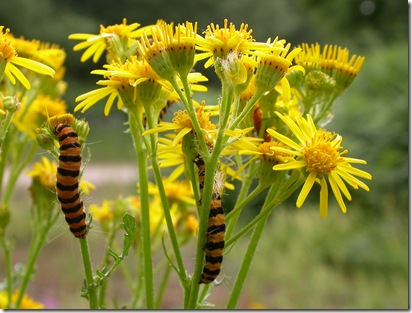Ragwort flowers with cinnabar moth caterpillars.
Since 2003 common ragwort has been a proscribed plant due to the Ragwort Control Bill, introduced largely to protect horses that can be poisoned by the plant. On nature reserves and roadsides as well as on farms and commons the plant has been pulled up in vast quantities. It is ironic that, although the horse population must be far lower than before the internal combustion engine, the dangers of the plant have only recently been a subject of legislation.
Many naturalists are concerned about this wholesale destruction of a plant that has been with us for many centuries, particularly as a very wide range of insects feed on the leaves and flowers. Indeed, the cinnabar moth has recently been made a Biodiversity Action Plan (BAP) species, due, no doubt, to the threat to ragwort.
Today I read the following about ragwort in a essay called Summer published in the book The South Country in 1909 by Edward Thomas (famous for his poem Adlestrop). He is talking of the top of the South Downs and I have little doubt that if such a quantity of the plant appeared there today the authorities of the new South Downs National Park would be quick to get rid of it:
"There a myriad oriflammes of ragwort are borne up on tall stems of equal height, straight and motionless, and near at hand quite clear, but farther away forming a green mist until, farther yet, all but the flowery surface is invisible, and that is but a glow. The stillness of the green and golden multitudes under the grey mist, perfectly still though a wind flutters the high tops of the beech, has an immortal beauty, and that they should ever change does not enter the mind which is thus for the moment lured happily into a strange confidence and ease."

No comments:
Post a Comment